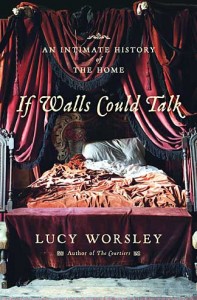
That’s almost always the first place you head in the morning, once you’ve gotten out of bed. And, come to think of it, thank goodness for beds. What would you do without a comfortable place to stretch out and snooze?
You’re grateful for your kitchen, too, because that’s the second place you go in the morning. You can’t live without your microwave, stove or fridge.
So how did those things come to be essential in a home? Find out by reading “If Walls Could Talk,” a new book by Lucy Worsley.
For the earliest part of human history, there were no bathrooms – or bedrooms, or kitchens, for that matter. Our ancestors slept, ate, procreated, and entertained, all in one big room. Residents of those early domiciles included extended family and, sometimes, others from the village. Great care was made by the latter group to be good guests and not make too many nocturnal noises or smells.

But smells were everywhere, and were hard to avoid. Pregnant women, in particular, were “confined” so that they wouldn’t be affected by “bad airs,” which were thought to be dangerous. Confinement often lasted seven weeks, post-partum and in a darkened room, which had to have been pretty bad in itself.
Perhaps because commoners didn’t have scads of new outfits to wear, few homes had clothes closets. Royalty had wardrobes for their clothing, and a vast staff of trusted people to look after the royal knickers. Closets were generally of the water sort, and one never dressed in a water closet.
Those very early potties were, naturally, expressly for kings and queens. Such a place may have a “closed stool” covered in velvet and, possibly, portraits of the royal spouse upon which one could gaze while tending to the, um, bottom line. And if you think your job is bad, check this: closed stools and their poorer cousins, the chamber pots, were emptied by women who were hired specifically for that task.
Other surprises in the history of the home: cooking was once the exclusive domain of men. Washing one’s hair was never advised during cold months. Cleaning material for the “nether end” was once cloth, and was re-used. And no matter in which century you lived, there was always another government tax…
Bouncing from doorway to dormer, “If Walls Could Talk” is one fun-to-read book, filled with delightful digressions that lead you around the rooms and into the corners of the average home or apartment. Like any good curator, author Lucy Worsley stops at several points in each space, giving us the history of various items and their uses, as well as fascinating word origins, the roots of customs, and some unsavory things that will make you do the “eeeuuuwww” face.
I loved this book. I wanted it to last and last.
If you read in bed or bath, or if you must have a book by your favorite easy chair, then this is the book to have. “If Walls Could Talk” has a lot to say.
The Bookworm is Terri Schlichenmeyer. Terri has been reading since she was 3 years old and she never goes anywhere without a book. She lives on a hill in Wisconsin with two dogs and 12,000 books.
